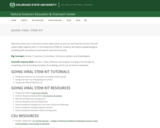
Going Viral STEM Kit. The Natural Sciences Education & Outreach Center collaborates with CSU faculty, National Parks and citizen science programs to translate their current scientific research into unique STEM experiences for students in the form of Educational Kits that can be checked out. Each kit contains just about all of the materials needed (minus common things like water and paper towels) to explore some really interesting scientific research topics.The kits are available for teachers and informal educators in Colorado to check out for a duration of a week by submitting either a local pickup form or a delivery form available at the linked website. Please use the contact information on the STEM Kit overview page to learn more. https://www.cns-eoc.colostate.edu/stem-kits/ This kit is provided free for educational use. This resource is also available in Spanish in the linked file.
- Subject:
- Applied Science
- Biology
- Career and Technical Education
- Chemistry
- Ecology
- Environmental Science
- Genetics
- Health, Medicine and Nursing
- Life Science
- Mathematics
- Measurement and Data
- Numbers and Operations
- Physical Science
- Ratios and Proportions
- Statistics and Probability
- Zoology
- Material Type:
- Activity/Lab
- Case Study
- Diagram/Illustration
- Interactive
- Lesson
- Lesson Plan
- Primary Source
- Reading
- Simulation
- Student Guide
- Unit of Study
- Provider:
- Colorado State University
- Provider Set:
- CSU Natural Sciences Education & Outreach Center
- Date Added:
- 02/06/2023
